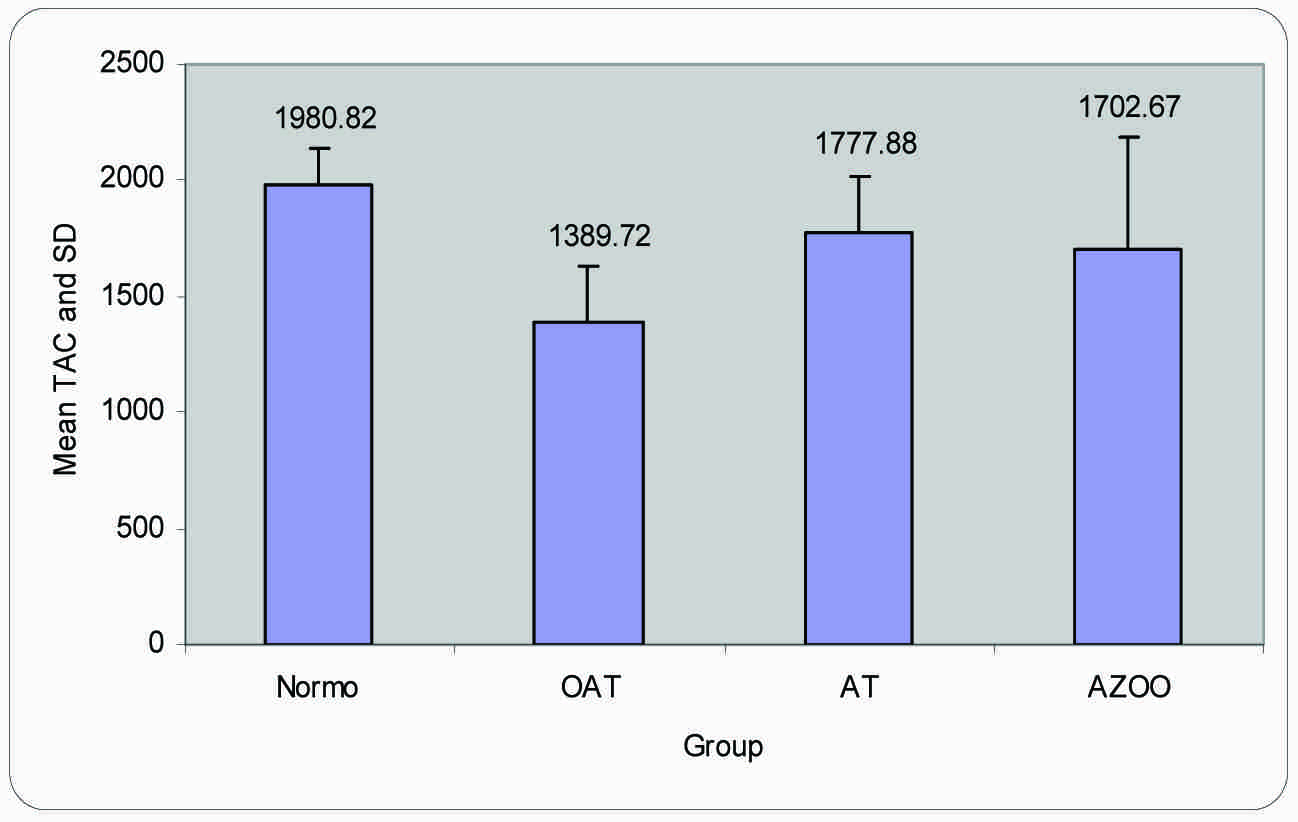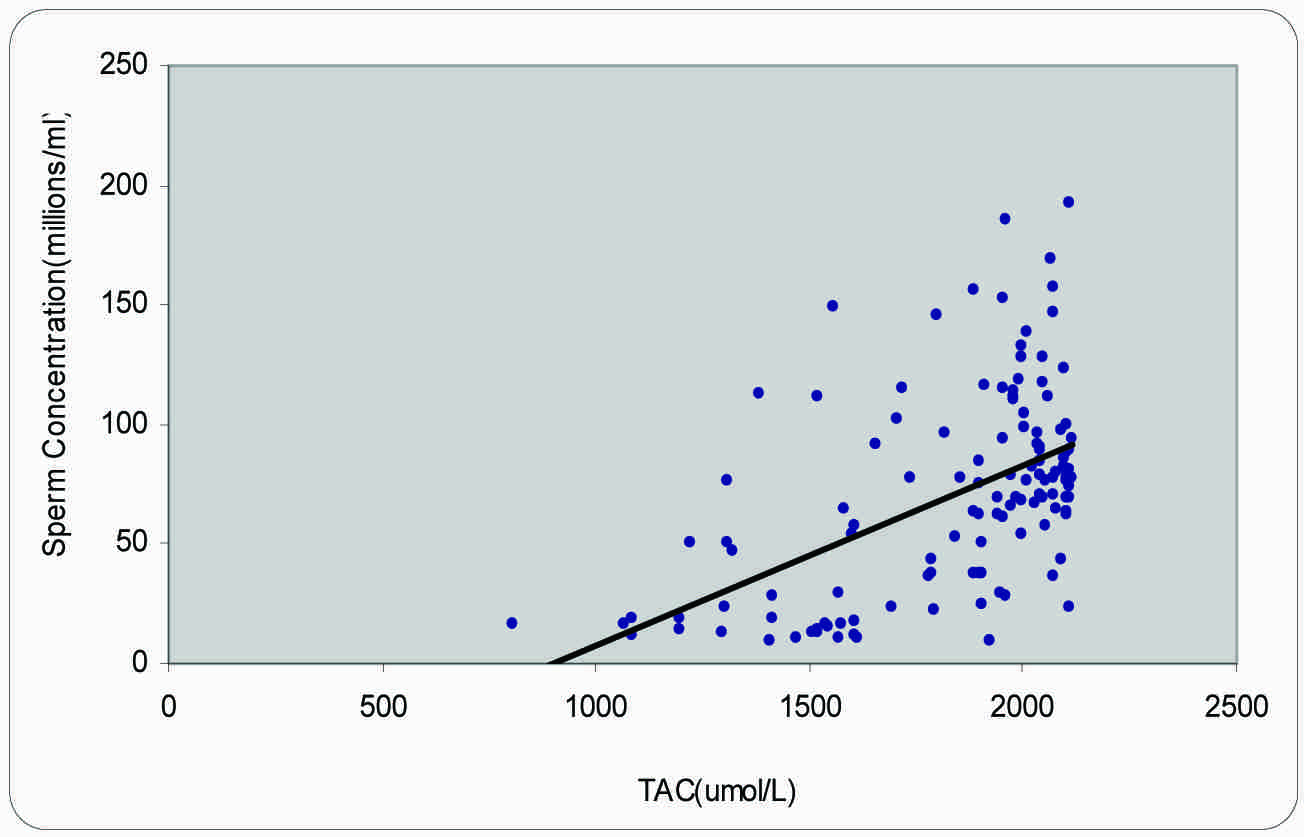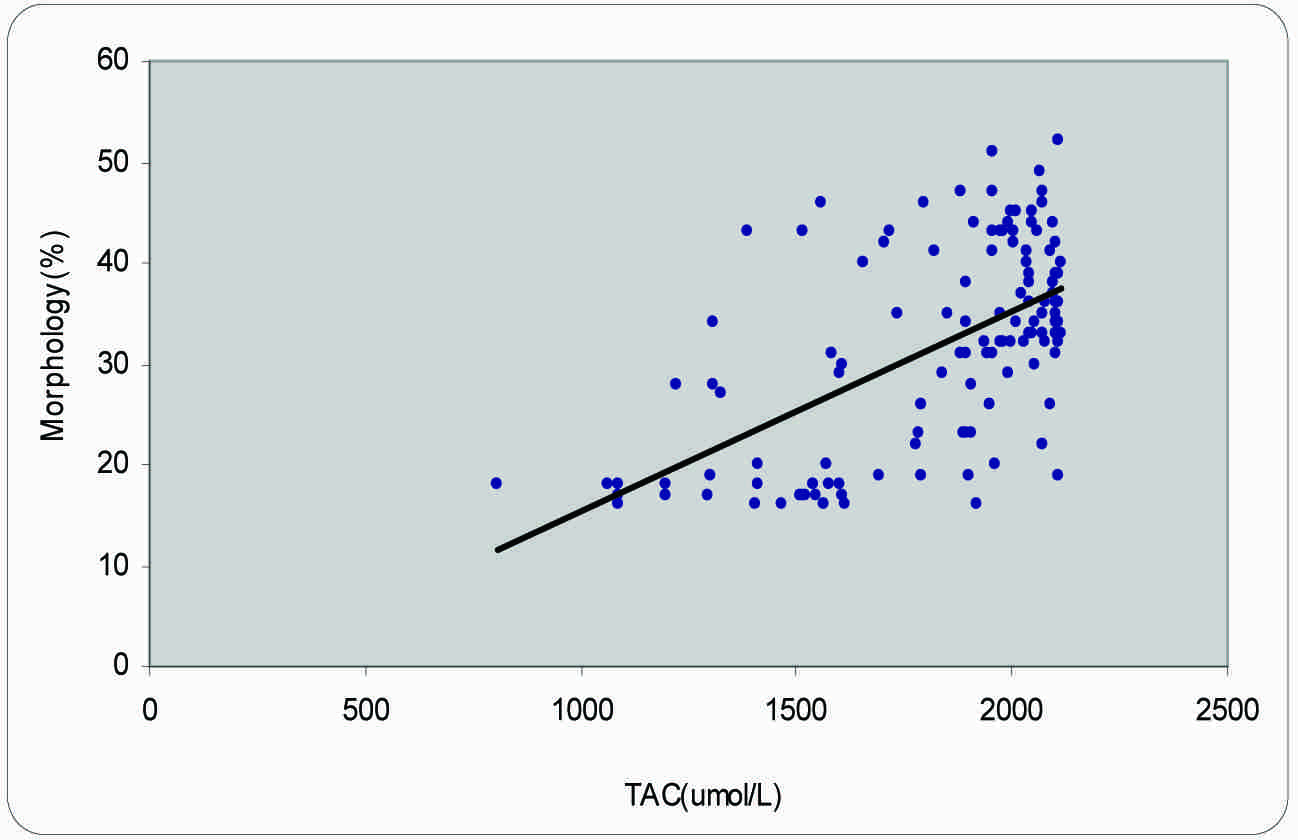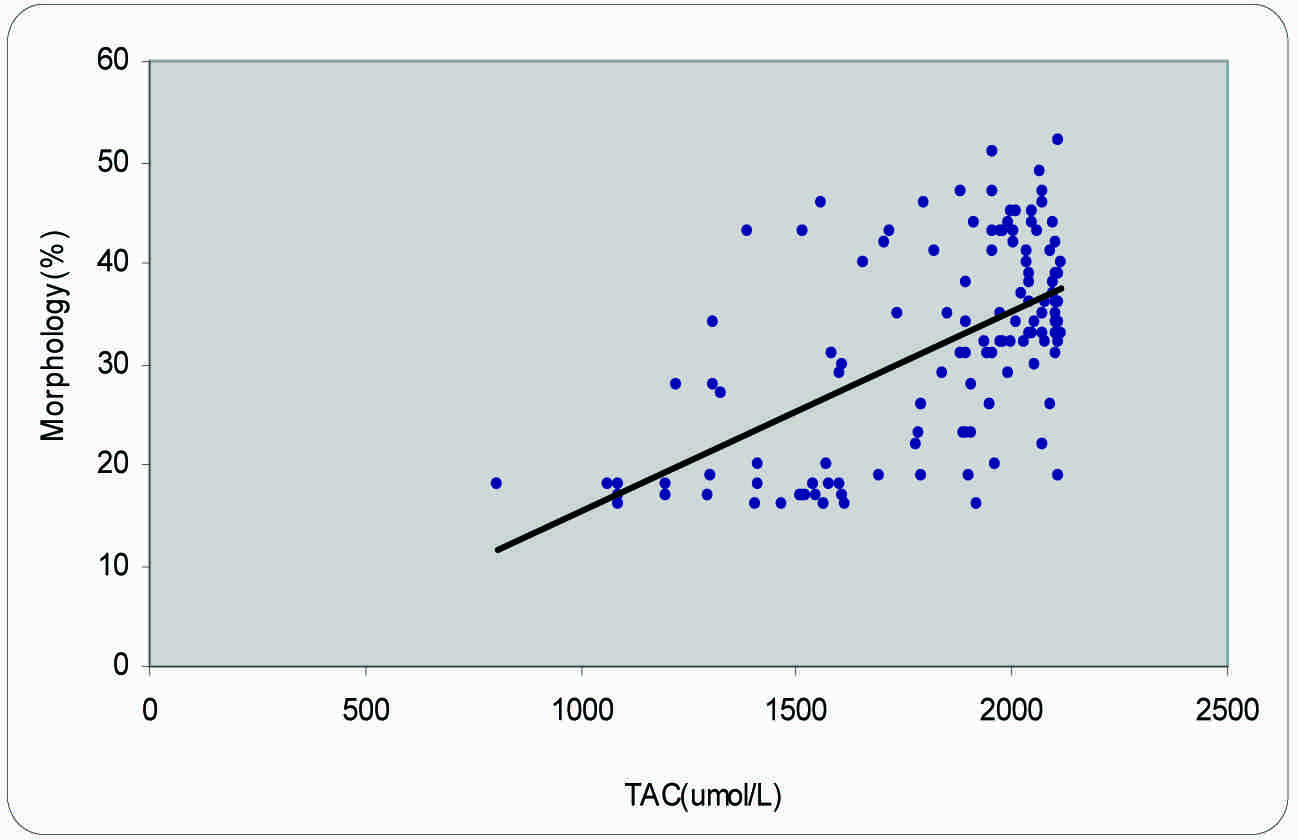The seminal plasma is well endowed with an array of antioxidants that act as free radical scavengers to protect the spermatozoa against oxidative stress. Oxidative damages which are caused to the sperms can reduce the sperm motility, interfere with the sperm-oocyte binding and fusion and they have been implicated as a cause of the male infertility [1]. The main antioxidative defence in the seminal plasma includes Superoxide dismutase, Catalase, Glutathione peroxidase, Vit-C (ascorbic acid), Vit.-E (tocopherol) and Zinc (Zn). This represents the total antioxidant capacity (TAC) [2]. The TAC and the individual antioxidants have been found to be low in infertile men [3].
The possibility that excessive reactive oxygen species generation by the human spermatozoa contributes to the aetiology of the male infertility was indicated by Aitken et al., [4,5].
These authors provided evidence, thus suggesting that the human spermatozoa could generate reactive oxygen species and that, in cases of male infertility, this activity was developed to the point that it overwhelmed the limited antioxidant defenses which were offered by these cells.The result of such an oxidative stress is the induction of lipid per oxidation in the sperm plasma membrane, suppression of the sperm functions, and the precipitation of the DNA damage to both the nuclear and the mitochondrial genomes [6].
These results have now been independently confirmed in many different laboratories [7,8]. As a result, there is now intense interest in the development and the evaluation of simple and convenient techniques for monitoring the generation of the reactive oxygen species by the human spermatozoa. For many decades, researchers have studied many markers of the oxidative stress-associated tissue damage and the antioxidant defenses, which included measurement of the antioxidant enzyme–superoxide dismutase. The advantage of FRAP test is that it can measure the antioxidant capacity of all the antioxidants in a biological sample and not just the antioxidant capacity of a single compound. From the clinical perspective, an accurate assessment of the patient’s TAC is an important factor in the diagnosis and management of the male infertility. The seminal TAC can be measured as the total available antioxidant protection in the seminal plasma by using a variety of colourimetric assays.
Measurement of the TAC by colourimetric assays is simple, rapid and economical. Measurement of the TAC of the seminal plasma gives an indirect measurement of the oxidative stress. Several methods have been developed to measure the TAC in the biological fluids, such as the oxygen radical absorbance capacity [9], the ferric reducing ability [10], and the phycoerythrin fluorescence-based assay [11]. The enhanced chemiluminescence assay, however, is the most commonly used method for measuring the TAC in the seminal fluid [12–17]. More recently, a reliable, accurate, more rapid and a simple colourimetric method has been developed.
MATERIAL AND METHODS
The present study was aimed at finding the total antioxidant capacity of the seminal plasma in subjects with impaired fertility potentials and to investigate its significance by correlating the TAC with different seminogram parameters.The semen samples were obtained from 150 male subjects who were selected from among the male partners of the infertile couples attending the Reproductive Biology Unit (Infertility Clinic) of the Department of Physiology, MGIMS, between the ages of 20-58 years. The cases of primary as well as secondary infertility were included in the study. They were referred from the Department of Obstretics and Gynaecology. A detailed history of the present and past illnesses, as well as that of the medical and surgical treatments were taken.
The clinical examination of the external genitalia was done at the Surgery OPD. This study was approved by the Institutional Ethics Committee of the Mahatma Gandhi Institute of Medical Sciences, Sevagram, Wardha, India. After explaining the purpose of the study, the procedure which was involved and the confidentiality of the data, informed written consents were obtained from all the subjects.
The subjects were asked to observe three days of sex abstinence and their semen samples were collected on the fourth day. The semen samples were collected by masturbation. After complete liquefaction of the semen samples at room temperature, each sample was tested for the physical seminogram parameters.
The subjects with varicocele, hydrocoele, undescended testes or any other structural abnormality, those with any history of a surgical intervention in the genitourinary tract and those with a treatment history with drugs like cancer chemotherapy, nitrofurantoin, niridazole, colchicine or any hormonal preparation which could directly suppress the spermatogenesis, were excluded from the study.
The Routine Semen Analysis
The routine semen analysis was done by using the SQA II C-P (Sperm Quality Analyzer) [Medical Electronic System Ltd. Israel] for the sperm concentration (millions/ml), the percent sperm motility and the percent normal sperm morphology and according to the WHO guidelines (WHO, 1992), the subjects were grouped into three categories, such as normozoospermic, oligozoospermic, asthenozoospermic and azoospermic.
Estimation of the Total Antioxidant Capacity (TAC)
After the evaluation of the physical parameters, 1 ml of semen sample was centrifuged at 3000 r.p.m.(revolutions per minute) for 20 minutes. Then, the supernatant plasma was taken for the estimation of the Total Antioxidant Capacity (TAC) by the Ferric Reducing Antioxidant Power Assay [10].
Principle: The FRAP assay measures the change in absorbance at 593 nm which owes to the formation of a blue coloured Fe++ tripyridyltriazine compound from the colourless oxidized Fe+++ form, by the action of electron donating antioxidants.
Reagents: 2,4,6 Tri (2-Pyridyl) 1,3,5-Triazine (TPTZ) (10mmol/lit)
Acetate Buffer (300mmol/lit)
Hydrochloric Acid (HCL) (40mmol/lit)
Ferric Chloride (FeCl3) (20mmol/lit)
Ferrous Sulphate (FeSO4) (1mmol/lit)
The Standard Solution: Fifty micro litres of standard Ferrous Sulphate (FeSo4, 7H2O) was dissolved in 1ml of the FRAP reagent, which was prepared by mixing TPTZ, HCL and FeCl3 in the ratio of 10:1:1 in serial dilutions which ranged from 100-1000nmol/L.
Procedure: To 50 micro litre of the seminal plasma, 1ml of the freshly prepared FRAP reagent was mixed uniformly and the absorbance was measured on a spectrophotometer.
[SYSTRONICS-UV 118] at 593nm against a blank which was prepared by adding 1ml of the FRAP reagent to distilled water and the concentration of the TAC was calculated.
STATISTICAL ANALYSIS
The statistical analysis of the data was carried out by using SPSS, version 17; The data was reported as mean ± SD.p values of less than 0.05 were considered as statistically significant. The correlation between the various parameters was evaluated by using the Spearman’s Rank correlation coefficients.
RESULTS
The mean values of the different seminogram parameters and the values of the total antioxidant capacity (TAC) in the subjects with normal and abnormal ejaculates have been shown in [Table/Fig-1].
Different Physical Parameters and TAC levels of semen in study group.
| Group | Sperm concentration (million/ml) | Sperm Motility (%) | Sperm Morphology (%) | Total Antioxidant Capacity (μmol/L) |
|---|
| Normozoospermics (n=80) | 96.25 ± 30.66 | 56.87 ± 8.66 | 38.65 ± 5.56 | 1980.82 ± 160.58 |
| Asthenoteratozoospermics (n=25) | 41.4 ± 12.64 | 37.88 ± 6.10 | 24.46 ± 4.39 | 1777.88 ± 239.87* |
| Oligoasthenoteratozoospermics (n=26) | 14.92 ± 4.67 | 19.46 ± 4.84 | 17.26 ± 1.04 | 1389.72 ± 242.11* |
| Azoospermics (n=19) | 0 | 0 | 0 | 1702.67 ± 485.95* |
*Values significantly different compared to control P< 0.05
The mean total antioxidant capacity (TAC) level of the seminal plasma (μmol/L) was found to be the lowest in oligoasthenoteratozoospermics (1389.72 ± 242.11), followed by the azoospermics (1702.67 ± 485.95), the asthenoteratozoospermics (1777.88 ± 239.87) and the normozoospermics (1980.82 ± 160.58) [Table/Fig-2].
TAC levels in seminal plasma of different groups (μmol/L)

The seminogram parameters, which included the sperm concentration, the sperm motility and the sperm morphology were found to be positively correlated with the seminal Total Antioxidant Capacity levels (‘r’ value: 0.533, 0.530 and 0.533 respectively) [Table/Fig-3].
Correlation between the seminal TAC and the seminogram parameters
| Mean ± SD | No. of subjects | Coefficient of Correlation(r) | p-value |
|---|
| TAC (μmol/L) | 1822.32 ± 302.87 | 131 | - | - |
| Sperm concentration million/ml | 61.13 ± 45.74 | 131 | 0.533 | <0.05 |
| Sperm motility(%) | 40.17 ± 21.89 | 131 | 0.530 | <0.05 |
| Sperm morphology (%) | 27.83 ± 14.19 | 131 | 0.533 | <0.05 |
The values for the TAC were significantly reduced in the subjects with impaired seminograms.
A significantly positive correlation was observed between the TAC and all the seminogram parameters [Table/Fig-3A,3B and 3C].
Correlation between seminal TAC and sperm Concentration

Correlation between seminal TAC & sperm motility

Correlation between seminal TAC andsperm morphology

DISCUSSION
In present study, we found the TAC was decreased in the abnormal ejaculates as compared to that in the normal ejaculate group. There was a positive correlation of the semen parameters with the Total Antioxidant Capacity (TAC) in the abnormal ejaculates. A defective sperm function has now been recognized as one of the most important causes of the male infertility. The seminal plasma possesses a rich source of different enzymatic and non-enzymatic antioxidants such as vitamin C (ascorbic acid), that protect the spermatozoa against oxidative stress which is one of the mediators of infertility, which causes sperm dysfunction and a low sperm quality. Growing evidences have indicated that an imbalance between the peroxidative and the antioxidative substances in the semen leads to metabolic and functional disorders of the male germ cells and that these may be a primary cause of some types of infertility [18].
It was reported that increased Reactive Oxygen Species (ROS) in the semen of infertile males could cause abnormal and immature spermatozoal morphologies, motilities and concentrations [19].
However, due to the high density of the mitochondria which may leak oxygen radicals in the cytoplasm, the ability of the spermatozoa in scavenging oxidants is limited. Therefore, the antioxidant capacity has to be present in the seminal fluid as well. That is why, the protection against ROS and the prevention of other damages are of critical importance and they can be provided by both enzymatic and non-enzymatic antioxidants [20].
Moreover, oxidative stress has been considered as a potential mechanism of the sperm DNA damage in infertile men [21].
It was found that the sperm DNA integrity was correlated with the seminal total antioxidant capacity [19]. The combined index from the ROS generation and the total antioxidant status score have been reported to be better markers of the oxidative stress [22].
Evidence has suggested that a low seminal Total Antioxidant Capacity (TAC) was related to the male infertility [14,23–25].
Other studies have stated that the total antioxidant levels in the patients with idiopathic infertility were significantly less as compared to those in the fertile group [3]. They concluded that the total antioxidant capacity might contribute to the pathophysiology of the male infertility, irrespective of the clinical diagnosis. Our results indicated that the total antioxidant capacity levels in the seminal plasma of oligoasthenozoospermic, asthenozoospermic and azoospermic men were significantly lower than those in normozoospermic men.
Moreover, we found that the reduced total antioxidant capacity levels were associated with impairment of the sperm concentration, motility and morphology. Our results are in accordance with those of Khosrowbeygi A et al., [26]. They reported that the TAC levels were significantly lower in the asthenozoospermic, asthenoteratozoospermic and the oligoasthenoteratozoospermic groups versus the control group.
Koca et al., showed that the seminal plasma TAC in infertile asthenozoospermic and asthenoteratozoospermic males was lower than that in fertile men [27].
Sharma et al., suggested that the ROS production and the TAC could be used as the markers of OS in the seminal fluid and that they were correlated with the male infertility. Thus, low levels of the TAC indicate that the antioxidants are utilized to detoxify the excessive amount of Reactive oxygen species. A positive correlation of the Total Antioxidant Capacity (TAC) with the seminogram parameters, which was found in our study, supported the fact that the reduced antioxidant power was mainly responsible for the impaired sperm quality, which could lead to infertility.
CONCLUSION
Our study suggests that the positive correlation of the Total Antioxidant Capacity (TAC) with the sperm parameters indicates that oxidative stress adversely affects the seminograms. Evaluation of the Total Antioxidant Capacity (TAC) can be used to decide on the diagnosis and the prognosis of the male infertility. The therapeutic usage of antioxidants in the treatment of male infertility should be studied extensively. A series of clinical trials are needed to investigate this aspect. Ongoing research with the use of this assay may allow the targeted antioxidants and other therapies to restore the fertility.
*Values significantly different compared to control P< 0.05